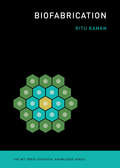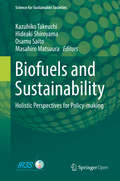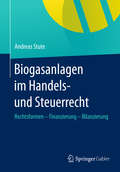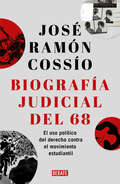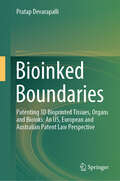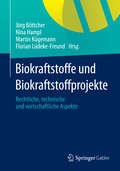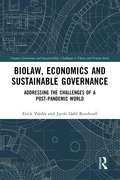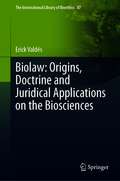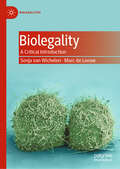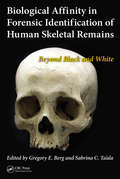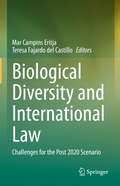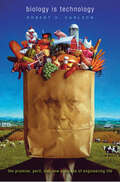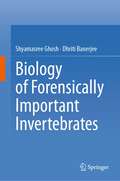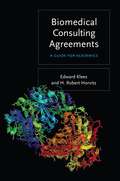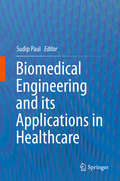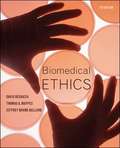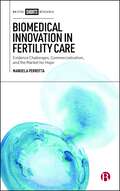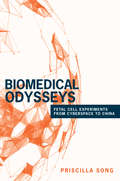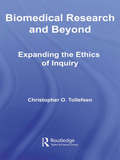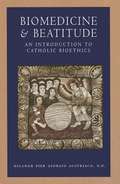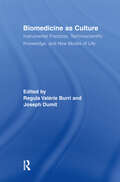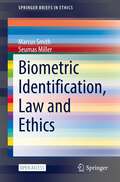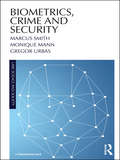- Table View
- List View
Biofabrication (The MIT Press Essential Knowledge series)
by Ritu RamanHow engineered materials and machines powered by living biological cells can tackle technological challenges in medicine, agriculture, and global security.You are a biological machine whose movement is powered by skeletal muscle, just as a car is a machine whose movement is powered by an engine. If you can be built from the bottom up with biological materials, other machines can be as well. This is the conceptual starting point for biofabrication, the act of building with living cells--building with biology in the same way we build with synthetic materials. In this volume in the MIT Press Essential Knowledge series, Ritu Raman offers an accessible introduction to biofabrication, arguing that it can address some of our greatest technological challenges. After presenting the background information needed to understand the emergence and evolution of biofabrication and describing the fundamental technology that enables building with biology, Raman takes deep dives into four biofabrication applications that have the potential to affect our daily lives: tissue engineering, organs-on-a-chip, lab-grown meat and leather, and biohybrid machines. Organs-on-a-chip (devices composed of miniature model tissues), for example, could be used to test new medicine and therapies, and lab-grown meat could alleviate environmental damage done by animal farming. She shows that biological materials have abilities synthetic materials do not, including the ability to adapt dynamically to their environments. Exploring the principles of biofabrication, Raman tells us, should help us appreciate the beauty, adaptiveness, and persistence of the biological machinery that drives our bodies and our world.
Biofuels and Sustainability: Holistic Perspectives for Policy-making (Science for Sustainable Societies)
by Hideaki Shiroyama Osamu Saito Kazuhiko Takeuchi Masahiro MatsuuraThis open access book presents a comprehensive analysis of biofuel use strategies from an interdisciplinary perspective using sustainability science. This interdisciplinary perspective (social science-natural science) means that the strategies and policy options proposed will have significant impacts on the economy and society alike. Biofuels are expected to contribute to reducing greenhouse gas emissions, revitalizing economies in agricultural communities and alleviating poverty. However, despite these anticipated benefits, international organizations such as the FAO, OECD and UN have published reports expressing concerns that biofuel promotion may lead to deforestation, water pollution and water shortages. The impacts of biofuel use are extensive, cross-sectoral and complex, and as such, comprehensive analyses are required in order to assess the extent to which biofuels can contribute to sustainable societies. Applying interdisciplinary sustainability science concepts and methodologies, the book helps to enhance the establishment of a sustainable society as well as the development of appropriate responses to a global need for urgent action on current issues related to biofuels.
Biogasanlagen im Handels- und Steuerrecht: Rechtsformen – Finanzierung – Bilanzierung
by Andreas StuteDieses Buch dient als Leitfaden für die Abbildung des betrieblichen Geschehens von Biogasanlagen sowohl im Handelsrecht als auch im Steuerrecht. Von der Gründung und Wahl der Rechtsform über die Finanzierungsphase zu den Herstellungs-, Vertriebs- und Verwaltungsprozessen werden wichtige Fragen immer mit Blick auf die bilanzielle Abbildung beantwortet. Der Aufbau des Buches orientiert sich chronologisch an diesen verschiedenen Phasen, sodass Praktiker, Buchhalter und steuerliche Berater jederzeit die richtige Hilfestellung finden. Zahlreiche Berechnungsbeispiele und Vorlagen machen das Werk zu einer wertvollen Arbeitshilfe.
Biografía judicial del 68: El uso político del derecho contra el movimiento estudiantil
by José Ramón Cossío DíazDetrás de los macanazos y las balas, hubo un sistema judicial que convalidó la represión y actuó convencido de su bondad. Nació el 26 de julio de 1968 y murió dos años después. Pero en su corta vida, multiplicó la iniquidad y la injusticia, provocó el encarcelamiento de decenas de jóvenes y evidenció la saña del Estado. Ésta es la historia -nunca antes contada- del proceso judicial contra los implicados en el 68 mexicano. Arranca con la apertura de una averiguación previa y expira cuando se dictan las sentencias condenatorias. En esta obra, que marca un parteaguas en los estudios sobre el movimiento estudiantil del 68, el exministro de la Suprema Corte José Ramón Cossío nos entrega una labor realizada por varias décadas: el análisis de los 60 tomos de aquel proceso, y presenta las evidencias que demuestran los vicios del juicio, las confesiones del ministerio público, las frases autoinculpatorias del juez y las defensas desesperadas de los estudiantes torturados que intentaban evitar Lecumberri.
Bioinked Boundaries: Patenting 3D Bioprinted Tissues, Organs and Bioinks: An US, European and Australian Patent Law Perspective
by Pratap DevarapalliThis book presents a comprehensive and comparative study of the patentability of bioprinting inventions, specifically bioinks and bioprinted tissues, in the US, the Europe and Australia. It employs a two-phase analysis to understand, ‘Is the patentable subject matter requirement a hurdle to patenting bioprinting inventions, specifically bioinks and bioprinted tissues?’ The first phase is a doctrinal analysis of the patent laws and jurisprudence in respective jurisdictions, highlighting the similarities and differences in their approaches to the subject matter requirement. The second phase is an empirical analysis of the patent prosecution data from patent applications filed in each jurisdiction with claims directed towards bioprinted tissues and bioinks, revealing how patent examiners apply the patent provisions to accept or object to such patent claims. The book offers several contributions to the field of bioprinting and patent law. First, it provides a detailed and up-to-date overview of the current state of the art and the legal landscape of bioprinting inventions. Second, it identifies the main criteria and factors that patent examiners use to assess the patentable subject matter of bioprinted tissues and bioinks, such as the level of human intervention, the markedly different characteristics, and the industrial applicability. Third, it proposes patenting framework models for each jurisdiction, which can assist patent applicants to draft and amend their patent claims in accordance with the patentable subject matter requirement. Fourth, it evaluates the potential benefits and implications of patenting bioprinting inventions for the bioprinting industry and society at large, such as fostering innovation, promoting public health, and indirectly addressing ethical and social issues. The main benefit that the reader will derive from the book is a deeper understanding of the patentability of bioprinting inventions, specifically bioinks and bioprinted tissues, in different jurisdictions and contexts. The book will help the reader to appreciate the legal and technical aspects of bioprinting and patent law, and how they affect the bioprinting industry and society at large.
Biokraftstoffe und Biokraftstoffprojekte: Rechtliche, technische und wirtschaftliche Aspekte
by Jörg Böttcher Nina Hampl Martin Kügemann Florian Lüdeke-FreundDieses Buch beschäftigt sich mit Biokraftstoffen und Biokraftstoffprojekten. Die Autoren zeigen auf, welche rechtlichen, agrarischen, ökologischen und ökonomischen Rahmenbedingungen von Biokraftstoffen beachtet werden müssen. Die Betrachtung dieser Rahmenbedingungen und weiterer - eher anlagenbezogener - Faktoren ermöglicht es dann, Rückschlüsse auf die Realisierung von Biokraftstoffvorhaben zu ziehen. Besonderes Augenmerk wird dabei auf den sensiblen Themenkomplex der Nachhaltigkeit von Biokraftstoffen gerichtet. Die anhaltende Diskussion unerwünschter sozialer, ökologischer und ökonomischer Effekte hat zu neuen und bislang nicht abschließend definierten gesellschaftlichen und politischen Ansprüchen an die Biokraftstoffindustrie geführt.
Biolaw, Economics and Sustainable Governance: Addressing the Challenges of a Post-Pandemic World (Finance, Governance and Sustainability)
by Erick Valdés Jacob Dahl RendtorffThis book offers an accurate and updated approach to the main contributions of cosmopolitan biolaw in relation to sustainability, global governance, organizational health care economics and COVID-19. Bringing together different robust and dense biojuridical epistemologies to analyze key bioethical problems as well as the health care, management, economics and sustainability issues of our time, it constitutes a paradigmatic text in its field. In addition to exploring different epistemologies and jurisdictional scopes of biolaw, including the relationships between this new field and the challenges which have arisen in the current globalized and technologized world, the book addresses controversial issues straight from today’s headlines: for example, the basics for health care, finance and organizational economics, global biojuridical principles for governance, globalization, bioscientific empowerment, global and existential risk and sustainability challenges for a post-pandemic world. The book encourages readers to think impartially in order to know and understand the bioethical and biojuridical dilemmas that stem from current economics and sustainability issues. Accordingly, it will be a valuable resource for courses in the fields of biolaw, law, bioethics, global sustainability, organizational health care economics, and global governance at different professional levels.
Biolaw: Origins, Doctrine and Juridical Applications on the Biosciences (The International Library of Bioethics #87)
by Erick ValdésThis book configures a consistent epistemology of biolaw that distinguishes itself from bioethics and from a mere set of international instruments on the regulation of biomedical practices. Such orthodox intellection has prevented biolaw from being understood as a new branch of law with legally binding force, which has certainly dwindled its epistemological density. Hence, this is a revolutionary book as it seeks to deconstruct the history of biolaw and its oblique epistemologies, which means not accepting perennial axioms, and not seeing paradigms where only anachronism and anomaly still exist. It is a book aimed at validity, but also at solidity because the truth of biolaw has never been told before. In that sense, it is also a revealing text. The book shapes biolaw as an independent and compelling branch of law, with a legally binding scope, which boosts the effectiveness of new deliberative models for legal sciences, as well as it utterly reinforces hermeneutical and epistemological approaches, in tune with the complexity of disturbing legal scenarios created by biomedical sciences’ latest applications. This work adeptly addresses the origins of the European biolaw and its connections with American bioethics. It also analyses different biolaw’s epistemologies historically developed both in Europe and in the United States, to finally offer a new conception of biolaw as a new branch of law, by exploring its theoretical and practical atmospheres to avoid muddle and uncertainty when applied in biomedical settings. This book is suitable for academics and students of biolaw, law, bioethics, and biomedical research, as well as for professionals in higher education institutions, courts, the biomedical industry, and pharmacological companies.
Biolegality: A Critical Introduction (Biolegalities)
by Marc de Leeuw Sonja van WichelenThis book provides a comprehensive analysis of the empirical and theoretical problems posed by the encounter between law and biology in the twenty-first century. How does biotechnology and new bioscientific knowledge affect our legal institutions, our sense of justice, and our ways of relating to one another? To answer these questions, authors Marc de Leeuw and Sonja van Wichelen examine the complex and often contested ways in which biotechnology and biological knowledge are reworked by, with, and against legal knowledge. As this book shows, recent developments in the life sciences—including molecular biology, immunology, and the neurosciences—and their applications in forensics, medicine, and agriculture test longstanding legal forms, such as property, personhood, parenthood, and (collective) identity, ultimately constituting the current field of “biolegality.” The authors argue that these biolegal contestations represent philosophical and anthropological challenges to existing understandings of exchange, self, kinship, and community. By addressing how biology and law inform new ways of relating and knowing, the book proposes a programmatic intervention, asserting the pivotal role the study of biolegality plays in advancing social and political theory.
Biological Affinity in Forensic Identification of Human Skeletal Remains: Beyond Black and White
by Gregory E. Berg Sabrina C. Ta’alaAncestry determination in the identification of unknown remains can be a challenge for forensic scientists and anthropologists, especially when the remains available for testing are limited. There are various techniques for the assessment of ancestry, ranging from traditional to new microbiological and computer-assisted methods. Biological Affinity
Biological Diversity and International Law: Challenges for the Post 2020 Scenario
by Mar Campins Eritja Teresa Fajardo del CastilloThe book focuses on the interactions between international legal regimes related to biodiversity governance. It addresses the systemic challenges by analyzing the legal interactions between international biodiversity law and related international law applicable to economic activities, as well as issues related to the governance of biodiversity based on functional, normative, and geographic dimensions, in order to present a crosscutting, holistic approach. The global COVID-19 pandemic, the imminent revision of the Strategic Plan for Biodiversity 2011-2020, and the Aichi Targets have created the momentum to focus on the interactions between the Convention on Biological Diversity and other international environmental regimes. Firstly, it discusses the principles that inspire biodiversity-related conventional law, the soft law that conveys targets for enforcement of the Biodiversity Convention, their structural, regulatory and implementation gaps, the systemic relations arising from national interests, and the role of scientific advisory bodies in biodiversity-related agreements. The second part then addresses interactions in specific conventional frameworks, such as the law of multilateral trade and global public health, and the participation of communities in the management of genetic resources. Lastly, the third part illustrates these issues using four case studies focusing on the challenges for sustainability and marine biodiversity in small islands, the Arctic Ocean, the Caribbean Sea, and the Mediterranean Sea, as a way to strengthen a horizontal and joint approach. The book is primarily intended for academics, researchers, and students interested in international environmental law and policy and in interactions for creating conditions for fair, sustainable, and resilient environmental development. By offering an analysis of instruments and criteria for systemic relations in those areas, it will also appeal to public and private actors at the domestic and international level.
Biological Evidence
by Ann Bucholtz Jon Lewis"The text is an introduction to the types of biological evidence commonly found at crime scenes and how to collect it for non-science majors and for professionals working in the criminal justice system. Specific biological evidence discussed includes blood, semen, saliva, urine, feces, hair, and fingernails. Additional topics include autopsy, the basic departments of the crime laboratory, toxicology, forensic entomology, and uncollectible biological evidence. Packaging, preservation, and care of biological evidence is discussed and chain of custody is explained. Additional topics include DNA, case studies, courtroom testimony, and exhibits for the courtroom.
Biologically Modified Justice
by Colin FarrellyTheories of distributive justice tend to focus on the issue of what constitutes a fair division of 'external' goods and opportunities; things like wealth and income, opportunities for education and basic liberties and rights. However, rapid advances in the biomedical sciences have ushered in a new era, one where the 'genetic lottery of life' can be directly influenced by humans in ways that would have been considered science fiction only a few decades ago. How should theories of justice be modified to take seriously the prospect of new biotechnologies, especially given the health challenges posed by global aging? Colin Farrelly addresses a host of topics, ranging from gene therapy and preimplantation genetic diagnosis, to an 'anti-aging' intervention and the creation and evolution of patriarchy. This book aims to foster the interdisciplinary dialogue needed to ensure we think rationally and cogently about science and science policy in the twenty-first century.
Biology Is Technology: The Promise, Peril, and New Business of Engineering Life
by Robert H. Carlson“Essential reading for anyone who wishes to understand the current state of biotechnology and the opportunities and dangers it may create.” —American ScientistTechnology is a process and a body of knowledge as much as a collection of artifacts. Biology is no different—and we are just beginning to comprehend the challenges inherent in the next stage of biology as a human technology. It is this critical moment, with its wide-ranging implications, that Robert Carlson considers in Biology Is Technology. He offers a uniquely informed perspective on the endeavors that contribute to current progress in this area—the science of biological systems and the technology used to manipulate them.In a number of case studies, Carlson demonstrates that the development of new mathematical, computational, and laboratory tools will facilitate the engineering of biological artifacts—up to and including organisms and ecosystems. Exploring how this will happen, with reference to past technological advances, he explains how objects are constructed virtually, tested using sophisticated mathematical models, and finally constructed in the real world.Such rapid increases in the power, availability, and application of biotechnology raise obvious questions about who gets to use it, and to what end. Carlson’s thoughtful analysis offers rare insight into our choices about how to develop biological technologies and how these choices will determine the pace and effectiveness of innovation as a public good.
Biology of Forensically Important Invertebrates
by Shyamasree Ghosh Dhriti BanerjeeThis book emphasizes the important role of invertebrates in forensic sciences in the detection of crimes, determining the time and place of death, estimating the minimum Post-Mortem Interval (PMI), and determining the cause of death. The initial chapter discusses the forensically essential invertebrates, especially flies under Order Diptera. Further, the book highlights the importance, biology, taxonomy, and biodiversity of flies under Order Diptera with forensic importance. It also discusses the Cuticular HydroCarbons (CHC) and spectrometry-based studies reported from flies and larvae of forensic importance. It further reviews the importance of DNA barcoding in molecular taxonomy-based studies on forensic flies through understanding, identification, and grouping the organisms. Towards the end, this book presents the applications and limitations of forensic entomology in cases of animal cruelty to a veterinary professional.
Biomedical Consulting Agreements
by Edward Klees H. Robert HorvitzThere can be a clash of cultures when academic scientists negotiate consulting agreements with biotechnology or pharmaceutical companies. Scientists, accustomed to the collegial atmosphere of the laboratory and sometimes disdainful of legal paperwork, might be less than diligent in reading the fine print. On the other hand, a company--motivated to protect discoveries and trade secrets--might write provisions that are favorable to its interests, leaving it to the scientist to raise objections or offer a counterproposal. The scientist, meanwhile, might believe that it would be impolite or antagonistic to raise questions about a company's agreement. This book offers an essential guide for academic scientists and physicians who are considering consulting work in the field of biomedicine. In it, the authors--an attorney and a Nobel Laureate in Medicine, both with extensive experience reviewing and negotiating consulting agreements--outline key issues to consider before signing a consulting agreement. These issues range from the obvious--intellectual property, confidentiality, and fees--to those that might not spring immediately to mind, including indemnity, different classes of stock, and the relevance of insider trading and securities laws.
Biomedical Engineering and its Applications in Healthcare
by Sudip PaulThis book illustrates the significance of biomedical engineering in modern healthcare systems. Biomedical engineering plays an important role in a range of areas, from diagnosis and analysis to treatment and recovery and has entered the public consciousness through the proliferation of implantable medical devices, such as pacemakers and artificial hips, as well as the more futuristic technologies such as stem cell engineering and 3-D printing of biological organs. Starting with an introduction to biomedical engineering, the book then discusses various tools and techniques for medical diagnostics and treatment and recent advances. It also provides comprehensive and integrated information on rehabilitation engineering, including the design of artificial body parts, and the underlying principles, and standards. It also presents a conceptual framework to clarify the relationship between ethical policies in medical practice and philosophical moral reasoning. Lastly, the book highlights a number of challenges associated with modern healthcare technologies.
Biomedical Ethics (Seventh Edition)
by David Degrazia Thomas Mappes Jeffrey BallardThis best-selling anthology of readings with case studies provides insightful and comprehensive treatment of ethical issues in medicine. Appropriate for courses taught in philosophy departments, bioethics programs, as well as schools of medicine and nursing, the collection covers such provocative topics as biomedical enhancement, clinical trials in developing countries, animal research, physician-assisted suicide, and health care reform. The text's effective pedagogical features include chapter introductions, argument sketches, explanations of medical terms, headnotes, and annotated bibliographies.
Biomedical Innovation in Fertility Care: Evidence Challenges, Commercialization, and the Market for Hope
by Manuela PerrottaAvailable Open Access digitally under CC-BY-NC-ND licence.This book analyses the clashes between evidence-based medicine and the dynamics of an increasingly privatised fertility care industry. With a unique focus on "add-on" treatments, it reveals how these controversial treatments are now widespread and can border on hopemongering.
Biomedical Odysseys: Fetal Cell Experiments from Cyberspace to China
by Priscilla SongThousands of people from more than eighty countries have traveled to China since 2001 to undergo fetal cell transplantation. Galvanized by the potential of stem and fetal cells to regenerate damaged neurons and restore lost bodily functions, people grappling with paralysis and neurodegenerative disorders have ignored the warnings of doctors and scientists back home in order to stake their futures on a Chinese experiment. Biomedical Odysseys looks at why and how these individuals have entrusted their lives to Chinese neurosurgeons operating on the forefront of experimental medicine, in a world where technologies and risks move faster than laws can keep pace. Priscilla Song shows how cutting-edge medicine is not just about the latest advances in biomedical science but also encompasses transformations in online patient activism, surgical intervention, and borderline experiments in health care bureaucracy.Bringing together a decade of ethnographic research in hospital wards, laboratories, and online patient discussion forums, Song opens up important theoretical and methodological horizons in the anthropology of science, technology, and medicine. She illuminates how poignant journeys in search of fetal cell cures become tangled in complex webs of digital mediation, the entrepreneurial logics of postsocialist medicine, and fraught debates about the ethics of clinical experimentation.Using innovative methods to track the border-crossing quests of Chinese clinicians and their patients from around the world, Biomedical Odysseys is the first book to map the transnational life of fetal cell therapies.
Biomedical Research and Beyond: Expanding the Ethics of Inquiry (Routledge Annals of Bioethics #Vol. 5)
by Christopher O. TollefsenWhat is the relationship between scientific research and ethics? Some think that science should be free from ethical and political considerations. Biomedical Research and Beyond argues that ethical guidance is essential for all forms of inquiry, including biomedical and scientific research. By addressing some of the most controversial questions of biomedical research, such as embryonic research, animal research, and genetic enhancement research, the author argues for a rich moral framework for the ethics of inquiry, based on the ideal of human flourishing. He then looks at other areas of inquiry, such as journalistic ethics, and military investigation, to see how similar they are to the ethics of scientific research. Finally, he looks at the virtues that must play a role in any life that is devoted to research and inquiry as a vocational commitment.
Biomedicine And Beatitude: An Introduction to Catholic Bioethics
by Nicanor Pier Giorgio Austriaco<P>How are the patient, the physician, the nurse, and the scientist called to grow in holiness in their particular vocations? This introductory text, written from within the Catholic moral tradition, narrates a bioethics that emphasises the pursuit of beatitude in the lives of those who are confronted by moral questions raised by biomedicine and the other life sciences. <P>The Catholic moral vision that informs this volume is rooted in the moral life described by the Lord Jesus Christ in his Sermon on the Mount. As Pope John Paul II taught in his moral encyclical, Veritatis splendour, we imitate Christ by seeking, with God's grace, to perfect ourselves through our actions and the virtues they engender. In this way, Catholic bioethics differs from other contemporary approaches to bioethics that focus on either the outcomes of human acts or the procedures that protect the autonomy of the human agent. <P>Besides ethical questions raised at the beginning and the end of life, Nicanor Austriaco, O.P., discusses the ethics of the clinical encounter, human procreation, organ donation and transplantation, and biomedical research. Finally, the text discusses the realities faced by citizens of faith living in a free and democratic society that is at the same time postmodern, secular, and liberal.
Biomedicine as Culture: Instrumental Practices, Technoscientific Knowledge, and New Modes of Life (Routledge Studies in Science, Technology and Society)
by Joseph Dumit Regula Valérie BurriThis volume offers interdisciplinary perspectives on contemporary biomedicine as a cultural practice. It brings together leading scholars from cultural anthropology, sociology, history, and science studies to conduct a critical dialogue on the culture(s) of biomedical practice, discussing its epistemic, material, and social implications. The essays look at the ways new biomedical knowledge is constructed within hospitals and academic settings and at how this knowledge changes perceptions, material arrangements, and social relations, not only within clinics and scientific communities, but especially once it is diffused into a broader cultural context.
Biometric Identification, Law and Ethics (SpringerBriefs in Ethics)
by Marcus Smith Seumas MillerThis book is open access. This book undertakes a multifaceted and integrated examination of biometric identification, including the current state of the technology, how it is being used, the key ethical issues, and the implications for law and regulation. The five chapters examine the main forms of contemporary biometrics–fingerprint recognition, facial recognition and DNA identification– as well the integration of biometric data with other forms of personal data, analyses key ethical concepts in play, including privacy, individual autonomy, collective responsibility, and joint ownership rights, and proposes a raft of principles to guide the regulation of biometrics in liberal democracies.Biometric identification technology is developing rapidly and being implemented more widely, along with other forms of information technology. As products, services and communication moves online, digital identity and security is becoming more important. Biometric identification facilitates this transition. Citizens now use biometrics to access a smartphone or obtain a passport; law enforcement agencies use biometrics in association with CCTV to identify a terrorist in a crowd, or identify a suspect via their fingerprints or DNA; and companies use biometrics to identify their customers and employees. In some cases the use of biometrics is governed by law, in others the technology has developed and been implemented so quickly that, perhaps because it has been viewed as a valuable security enhancement, laws regulating its use have often not been updated to reflect new applications. However, the technology associated with biometrics raises significant ethical problems, including in relation to individual privacy, ownership of biometric data, dual use and, more generally, as is illustrated by the increasing use of biometrics in authoritarian states such as China, the potential for unregulated biometrics to undermine fundamental principles of liberal democracy. Resolving these ethical problems is a vital step towards more effective regulation.
Biometrics, Crime and Security (Law, Science and Society)
by Marcus Smith Monique Mann Gregor UrbasThis book addresses the use of biometrics – including fingerprint identification, DNA identification and facial recognition – in the criminal justice system: balancing the need to ensure society is protected from harms, such as crime and terrorism, while also preserving individual rights. It offers a comprehensive discussion of biometric identification that includes a consideration of: basic scientific principles, their historical development, the perspectives of political philosophy, critical security and surveillance studies; but especially the relevant law, policy and regulatory issues. Developments in key jurisdictions where the technology has been implemented, including the United Kingdom, United States, Europe and Australia, are examined. This includes case studies relating to the implementation of new technology, policy, legislation, court judgements, and where available, empirical evaluations of the use of biometrics in criminal justice systems. Examples from non-western areas of the world are also considered. Accessibly written, this book will be of interest to undergraduate, postgraduate and research students, academic researchers, as well as professionals in government, security, legal and private sectors.
